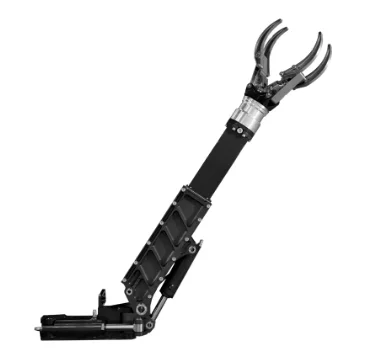In today's fast-paced industrial landscape, efficiency and precision are crucial. That is where hydraulic manipulators come in. Using these ingenious machines has revolutionized the way we handle heavy loads, making it easier, safer, and more efficient to perform tasks.
Whether you're in manufacturing, logistics, or any industry that involves lifting and moving heavy objects, a hydraulic manipulator is your ultimate ally. It is a powerful tool that offers numerous advantages that can significantly improve productivity while ensuring the utmost safety for operators, thanks to its impressive strength and versatility.
We will explore hydraulic manipulators in depth in this blog post. From understanding how they work to exploring real-world applications across a wide range of industries - we've got everything covered. Discover why these remarkable machines are becoming an essential asset for businesses worldwide by diving right in!
Hydraulic Manipulators: How They Work
Have you ever wondered how hydraulic manipulators work? Let's explore the inner workings of hydraulic manipulators and find out how these powerful machines work.
An actuator or cylinder, a control valve, and a hydraulic pump make up the core components of a hydraulic manipulator. Through hoses or pipes, the hydraulic pump pressurizes the fluid (usually oil), which is then distributed through the system. Different actuators are controlled by control valves based on the flow and direction of this pressurized fluid.
There are two types of actuators commonly used in hydraulic manipulators: cylinders and motors, which convert fluid power into mechanical motion.
In a cylinder, piston rods push or pull loads within sealed tubes filled with pressurized fluid. In a motor, fluid energy is converted into mechanical torque using gears or other mechanisms.
By adjusting the flow rate and direction through control valves, operators can control the speed and force exerted by a hydraulic manipulator with great accuracy.
Insights into hydraulic manipulators' immense capabilities can be gained by understanding how they work. In addition to providing smooth movements, excellent load handling capacity, and precise positioning, these versatile machines are indispensable for a variety of industries, including manufacturing, construction, and healthcare.
Hydraulic Manipulators Have Many Advantages
This versatile piece of equipment is designed to handle heavy loads with precision and ease. Hydraulic manipulators can boast numerous advantages in industrial automation and material handling.
A hydraulic manipulator has the major advantage of lifting and moving heavy and cumbersome objects that would otherwise be difficult to move by hand. In addition to saving time, this machine also reduces the risk of injury for workers because of its powerful hydraulics. With its hydraulics, it can effortlessly handle weights ranging from a few kilograms to several tons.
Its flexibility in reach and positioning is another advantage. It is possible to adapt hydraulic manipulators to different tasks and industries by attaching different attachments such as grippers, suction cups, or specialized tools. You can use these machines to lift, rotate, tilt, or stack materials.
As a consequence of their proportional valves and advanced control systems, hydraulic manipulators provide precise control over movements. In order to ensure optimal handling without damaging delicate items, operators can easily adjust the speed and force applied during lifting operations.
Hydraulic manipulators are also known for their durability, in addition to their strength and versatility. In demanding environments like factories and warehouses, these machines are built with robust materials like steel alloys. In addition to being maintenance-free, they can also withstand harsh conditions without compromising performance.
A hydraulic manipulator offers clear advantages, including increased productivity, improved safety levels, enhanced precision, adaptability, and long-term reliability.
It doesn't matter if you work in manufacturing, logistics, or any other industry where material handling plays a vital role.

Hydraulic Manipulators: Applications
We will explore some of the key areas where hydraulic manipulators are used, thanks to their versatility and precision.
In manufacturing and assembly lines, hydraulic manipulators play a crucial role in lifting heavy objects with ease. They can be programmed to perform repetitive tasks, reducing the strain on human workers and increasing efficiency. Hydraulic manipulators offer precise control and enhanced productivity from moving large components in automotive production to handling delicate items in electronics manufacturing.
Excavating trenches, lifting construction materials, and manipulating heavy equipment are some of the tasks that hydraulic manipulator arms perform in the construction industry. It is safer for workers to handle heavy loads at elevated heights or in precarious positions with these machines because of their strength and dexterity.
Surgical procedures often require precise movements when positioning instruments or assisting surgeons during complex operations, which benefits from hydraulic manipulator technology as well. The use of hydraulic manipulators allows medical professionals to maintain steady control while minimizing fatigue.
Additionally, logistics companies rely on hydraulic manipulator systems for efficient loading and unloading processes within warehouses and cargo containers. These devices improve speed and accuracy by effortlessly moving bulky goods without risking damage.
Research laboratories also use hydraulic manipulation technology for delicate experiments that require controlled movements with utmost precision, such as manipulating fragile samples under a microscope or performing complex scientific experiments.
Despite only highlighting a few uses for hydraulic manipulators, they illustrate how this advanced technology is revolutionizing various industries by improving productivity levels while maintaining safety standards.
Hydraulic Manipulator Maintenance and Safety Tips
Here are some tips to help keep your hydraulic manipulator running smoothly and safely. You should ensure proper maintenance and follow safety guidelines when using a hydraulic manipulator.
The hydraulic hoses, fittings, and connections should be inspected regularly for wear and damage. Any worn-out parts should be replaced immediately to avoid accidents or breakdowns.
The hydraulic fluid level should always be maintained. Regularly check the fluid reservoir and top up as needed. Proper lubrication helps prevent overheating and equipment failure.
You should also be cautious when operating a hydraulic manipulator near electrical sources or flammable materials. Make sure there is no risk of oil leaking onto these hazards by regularly inspecting seals and connectors.
Additionally, training operators on safe handling techniques is essential in preventing accidents. Make sure everyone understands how to use the controls correctly and how to shut down the machine in case of an emergency.
If the hydraulic manipulator is overloaded, it can cause undue stress on components, causing malfunctions or even catastrophic failures.
Follow these maintenance tips and prioritize safety measures to maximize the lifespan of your hydraulic manipulator while minimizing risks.

Conclusion
Hydraulic manipulators have numerous advantages in various industries. Due to their versatility, precision, and strength, they are indispensable tools for handling heavy loads and performing intricate tasks. Hydraulic manipulators enhance productivity and safety in manufacturing, construction, and logistics.
Businesses can optimize their operations and streamline their processes by understanding hydraulic manipulators and their key features. Even the most challenging tasks can be handled easily with the manipulator because it can be customized to meet specific requirements.
In addition, hydraulic manipulators have many applications. From lifting heavy objects to assembly line operations, these machines provide solutions for a variety of industries. By reducing manual labor, they improve efficiency and ensure worker safety.
Maintaining a hydraulic manipulator is also crucial. Regular inspections and proper upkeep will ensure its longevity and prevent any unexpected breakdowns or accidents. To mitigate potential risks, operators must also adhere to safety guidelines – they need proper training on how to operate the equipment safely.
A hydraulic manipulator such as CathayBot provides businesses across various sectors with significant advantages. By simplifying complex tasks and improving worker safety with ergonomic design features, it enhances productivity and improves worker safety. In modern industrial settings, this powerful machine has become an indispensable tool due to its durability and adaptability.







